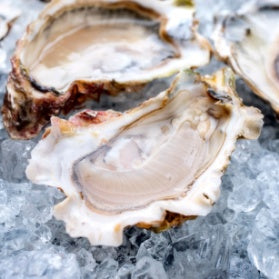Your Cart is Empty
FREE SHIPPING ON ALL ORDERS OVER $125!
FREE SHIPPING ON ALL ORDERS OVER $125!
FREE SHIPPING ON ALL ORDERS OVER $125!
TL;DR: Correctly thawing fish maintains peak flavor, texture, and freshness. Avoid thawing at room temperature, in hot water, or using a microwave. The best method of thawing is in the refrigerator overnight.
Main Points:
What’s the difference between the best fish dinner you’ve ever had and the soggiest, most flavorless filet you’ve ever suffered through? Odds are good that one was thawed correctly, and the other was hastily defrosted in the sink moments before cooking.
It’s easy for home chefs to send the delectable flavor of their seafood down the drain—often literally! Even the highest-quality frozen seafood will flop if you don’t take the time to thaw it the right way. Sometimes, thawing fish the wrong way can even make it unsafe to eat.
If you want to cook your favorite fish dinner right, you need to learn to thaw fish like a professional. Continue reading to learn how to preserve the ocean-fresh flavor and texture you crave!

First, let’s review the most common mistakes that home cooks tend to make when preparing frozen fish.
It may seem logical to set your frozen fish on the counter to thaw while you go about your day. The longer you leave seafood at room temperature, the faster bacteria will multiply on the surface of your food. Bacteria tend to flourish at temperatures above 40 degrees Fahrenheit. Assuming you don’t live in an igloo, your kitchen is likely too warm, and it isn’t worth the risk.
Likewise, moving your delicate filet from the freezer to the counter is a major temperature change. Even if you avoid bacteria, leaving fish out can cause unpleasant changes in the texture of your seafood. As a result, you’ll miss out on the light and flaky fish dinner you had in mind. Nobody likes waterlogged salmon!
You forgot you’d committed to cooking fish tonight, and the lovely salmon steak you brought home is still frozen solid. With an hour or two until dinner, it seems logical to defrost it under hot water in the sink.
Unfortunately, any rapid shift in temperature has the potential to destroy the fish’s texture. A sudden change from the chilly depths of the freezer to a boiling sink bath will leave you with a half-poached mess.
Not only will your delicious seafood end up waterlogged and lose its natural flavor, but the hot water has a high probability of breeding bacteria. The speed of this ill-advised defrosting method is simply not worth the risk.
You want to thaw your fish quickly, and your microwave has a convenient “defrost” setting. Is it safe to use it to thaw fish fast?
If you’ve ever accidentally exploded something in the microwave, you know it’s not a very consistent tool. It may defrost your fish, but it will defrost it unevenly. The result? More texture issues.
It’s also common for the thinner parts of your seafood to begin to cook on the defrost setting. The result will be a nightmare of uneven textures and doneness. The flavor will likely suffer, too.

Unfortunately for last-minute chefs, the best way to thaw frozen fish requires several hours of forethought. Experts recommend defrosting your fish in the refrigerator overnight. By defrosting fish below room temperature, you’re preventing bacteria growth. Plus, a slow thaw preserves the fish’s texture and natural moisture level, ensuring it remains flaky and flavorful.
Ideally, you should remove the frozen fish from its original packaging and place it in a kitchen-safe plastic bag or plastic wrap. Place this in a container or bowl to catch any drips and to avoid cross contamination before placing it in your refrigerator for a minimum of 8 hours, or until fully defrosted. Very thick portions might need more time to thaw completely.
You can leave defrosted fish in the refrigerator for up to two days after thawing it. Even so, it’s best to cook your fish fairly quickly after it's fully defrosted.
Hindsight is 20/20 and doesn’t help you much when you have company on the way. If you need to thaw fish fast, consider using cold water. Place your fish in a sealable bag and submerge it in cold water for approximately 10 minutes. You may need to need to double bag it to avoid any leakage and replace the water periodically as it approaches room temperature.
Even if you thaw fish the right way, we recommend a quick sensory inspection before you begin cooking.
If you thaw your fish correctly, frozen fish can be fresher and safer than “fresh fish.” Frozen seafood has significantly improved with advancements in freezing technology over the last couple of decades. For example, North Coast Seafoods’ frozen fish is flash-frozen within hours or even minutes of harvest, locking in peak freshness, texture, and flavor. The proper defrosting method ensures your favorite frozen filet will taste dock-fresh and delicious every single time!
Are you ready to give these professional thawing methods a shot? North Coast Seafoods has the delectable frozen fish you crave! Visit our site to order sustainable seafood like shrimp, salmon, crab, & more, right online!
Shoot us an email or fill out our Contact Form.
Comments will be approved before showing up.



Sign up to receive the best seafood recipes, first access to new products, exclusive discounts and more!